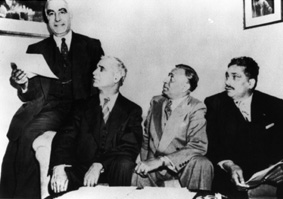





|

|
Today there are laws to help protect all people from suffering such indignities. But it took someone to stand up for his or her
rights before things changed. In the Sikh community there is always someone who stands up to lead the fight. It is part of being
a Sikh.
In some respects, racism and incidents of discrimination brought the Sikhs closer together as a group and strengthened their
resolve. But they never became insular; in fact, they had strong allies amongst white people who helped them fight the battle
against injustice and discrimination.
Since most Sikhs worked in the lumber industry, another major focus for the Sikh community was the union movement. The

|
Sikh community leaders, 1946.
Left to right: Mr Kartar Singh Kundal, Mr Kapoor Singh, Dr. D. P. Pandia, and Mr. Mayo Singh
|
Sikhs had been receiving lower wages in the mills than the white men and had been excluded from the better and higher-paying
jobs for far too long. There was a need for fairness and job security on the labor front. Mr. Darshan Singh Sangha was a major
force in the Sikh community as an organizer for the International Woodworkers of America. " The first time I went into the mills
to organize, I went to Mayo’s mill, to Youbou and Honeymoon Bay. At first when I went into these mills it would seem that the
only people that I could talk to were the ones that were slightly progressive. Once I was offered a very nice job if I would
agree to cease working with the union, in Mayo’s mill, a job in the office.
Then in 1946, when the IWA tried to assemble workers together to form a union, there was tremendous support from the
workers. Even the most backward workers were coming up to the IWA. At that time the union gave the owners some
demands: that wages be increased by 25 percent, a forty-hour work week, time and a half for overtime and vacation time.
There was to be union security, and union dues were to be deducted at the mill. These conditions being demanded by the union
did not exist in any mill at this time. For this reason it took a very long time. By then the union was 28,000 strong. That summer
(1946) there was a very big strike in BC, and it was 100 percent successful. I think the strike lasted thirty days. "
With the end of the war in 1945 there was generally a greater concern for human rights and fair play. The CCF (Cooperative
commonwealth Federation, later renamed the New Democratic Party) and the IWA both sided with the East Indians in their
fight for the franchise. Dr. Pandia headed the group that presented a brief to the Federal Election Act Committee in 1946. This
brief was accepted and the committee recommended the necessary changes in the Act to give the franchise to the East Indians.
It was enacted into law on April 2, 1947, and on September 15, 1947 East Indians were granted the municipal franchise.
The Sikhs had finally become Canadians. Mr. Manga S. Jagpal says that on the day they got their rights the Sikhs got dressed
up in their best suits and went downtown. There they proudly lined up to eat at the fancy restaurants that had previously refused
them service. By law, they had to serve them now, and they did. The Sikhs could now call Canada their home.
 Karm S. Manak: Discrimination
Karm S. Manak: Discrimination
|
|
Next Section...
[p.3]









|







